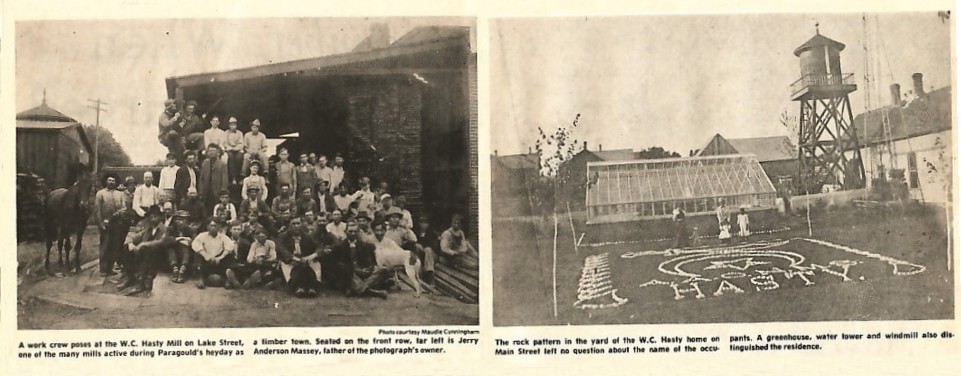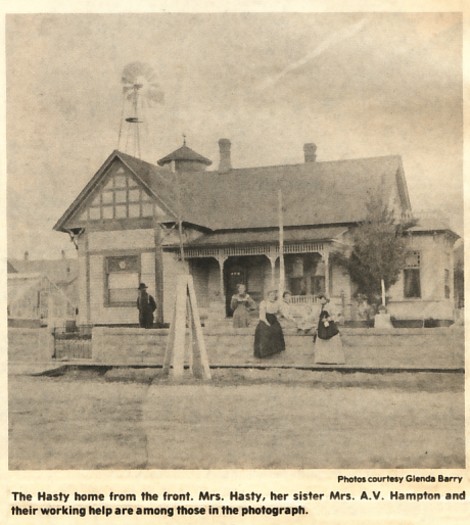
Greene County Arkansas
Paragould, Arkansas
Centennial Edition Section 5
6- Section 5, Centennial Edition Paragould Daily Press, Monday, August 29,1983
==============================================================================================================
 |
|
A work crew poses at the W. C. Hasty Mill on Lake Street, one of the many mills active during Paragould's heyday as a timber town. seated on the front row, far left is Jerry Anderson Massey, father of the photograph's owner.
|
The rock pattern in the yard of the W. C. Hasty home on Main Street left no question about the name of the occupants. A greenhouse, water tower and windmill also distinguished the residence. |
| Whippletrees and adz
at local lumber firms I'm not old enough to remember all the 37 woodworking mills in Paragould that I've been told there were. I do remember the J. F. Hasty and Son Cooperage (barrel) plant in oper- ation. My father, T. E. Clifford, led me into it as a lad of 5 or 6 years old. It's a shame one didn't have a movie camera and colored film to record this beautiful sight. The barrels were set up for assembly on a hearth abut a foot high. Three men worked as a team. The shop was very dark. Windows had long ago smoked up --if there were windows -- and a fire, which must have used wood, was in the center of the hearth like a black-smith forge. Many sparks were flying and reflections off the sweaty bodies of the men stripped to the waist was indeed a sight to behold. The Hasty cooperage was east of the St. Louis Southwestern Railway at the east end of East Hunt Street. Most old timers knew the story about Uncle Henry Wrape, "Big Henry." At a board meeting, he recommended the company cut slack barrel staves (then used as shipping containers). He saw a good future in slack barrels. It was promptly voted down. The meeting continued and as business at hand came to an end,Uncle Henry arose and said "Gentlemen", whether you like it or not, the Wrape Company is going to cut slack staves. Meeting adjourned. The nephews and grandsons used anything and everything that would make a slack stave -- any soft wood. They tried to cover up the world, rent- ing ground all the way to C Street to air-dry them. World War I came along. All were sold and more needed. Lumber as such as not sawed, to my knowledge, on any great scale. Ross Coffman had a sawmill on East Court Street. There were many others around that cut house patterns for local use, bridge timbers, etc. Our family's planing mill, on East Lake Street west of the railway, used "bolts" and "blocks" from there. My mother's father, John Good, and mother's uncle, Dave Good, manufactured: kegs, cast, barrels, boxes, handles of every description, axes, adz, hoes, rakes, picks, mauls, hammers,drawing knife -- or "spoke shave" --handles, sucker-rods, buggywhips to whippletrees, spokes and hubs for every wood wheel made at that time.Also molding, flooring, neat ceiling, wainscoating, baten, lacelike-barger-boards, jigsawed brackets and curlicues. Most of their woodwork was long been removed but there are still signs of it on many structures (also see pic- tures in the Centennial Cookbook). |
I told Joe Straub, a well-known car- penter who was repairing his house at Highland and Second streets, that my great uncle Dave had made those flamboyant curvileanor brackets. "My God," he said, "it looks like that would drive a man nuts." "He died in the asylum," I said. Joe's mouth flew open like he had a bee in it. I still don't know whether I had no respect for my elders or whether he had given me the reason for Uncle Dave being there! But you know, I felt better. The Hickson and Rodgers Manufac- turing Company was farther from home. It made dowell pins, staves, spokes and hubs. I didn't know any- thing about it until after 1918. Sometime in the 20s, I became a Western Union messenger and hand- led an order for pins for Hickson- Rodgers. I was told to call it in by phone. This I did, but they requested that it be delivered. It was duly done. E. H. Borneman seemed to read it two or three times before signing for it. I wanted to leave but was told to wait. He then unlocked a walk-in vault, went in, fumbled around and brought me a dollar bill. He hardly said a word but I want you to know Hickson-Rod-gers got service, if I had anything to do with it. And I always got that dollar bill. Dowell pins were punched by very fast-running machines, from blanks or blocks which were fed into the punch by hand. That punch didn't know a finger from a block. I always worried about Charley Ward, who ran a punch, until he pulled his glove off and showed me no finger on that hand that he used. A word or two about other indus- tries. We had lots of gins -- not the drinking kind. Also grain and flour mills. Numerous grist mills, cream stations, creamery (butter and ice cream), ice plants, mattress factory, poultry and eggs, tile and building block factory, brick plant, machine shops, a host of blacksmiths and an opera house. But probably the most hair-raising and exciting was the stock market -- four-footed stock market. Both railways had stock pens which were used to feed, water and rest stock on the way to market at St. Louis,. Stock was not hauled then; you drove them. And it was not uncommon for half a dozen men on horseback to herd a drove of cattle that would fill the street for a block or more. The trail boss always had permission from the marshall. Of course, the cattle wanted to dart into every opening they could find, which really was not to serious unless you had a garden or flower beds or wash hanging on the line. Then it would be a very foolish person who would try to smooth the ruffled feather of the owner of that clean wash. We all had a part in the progress, the housewives and the children: We ran for our lives. Tom Clifford ========================= |

The Hasty home from the front. Mrs. Hasty, her sister Mrs. A. V. Hampton
and their working help are among those in the photograph. ===================================================================
|
Transcribed by: PR Massey
Return to Greene County, Arkansas Centennial Edition
Return to Greene County, Arkansas Newspapers
Return to Greene County, Arkansas Index Page
©2011 PR Massey